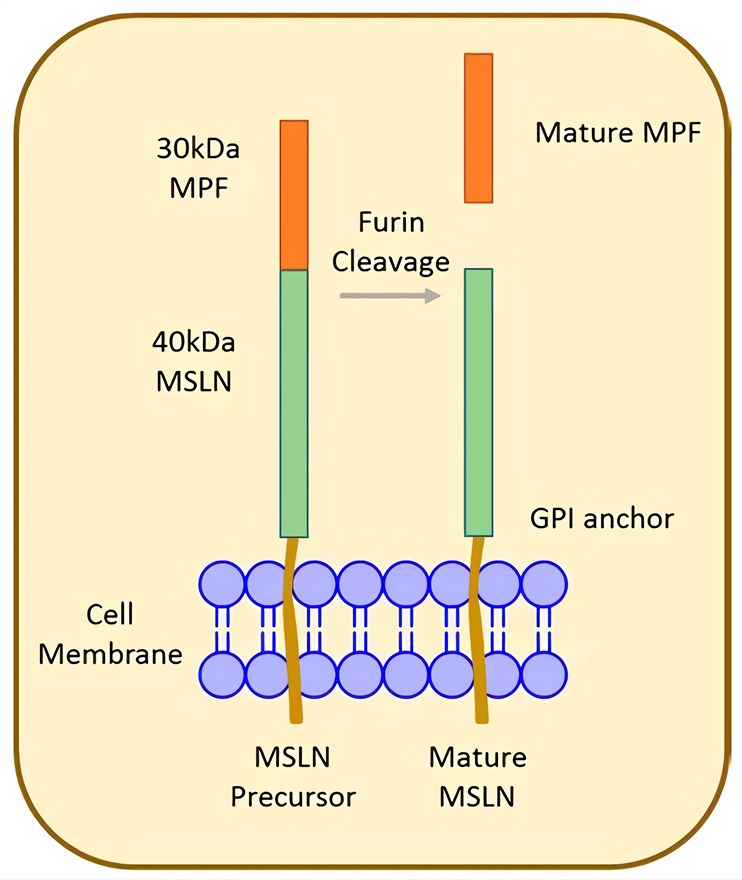MSLN Assay Portfolio Service
Structure of Mesothelin (MSLN)
MSLN is a 40 kDa glycosylphosphatidyl-inositol (GPI) linked protein that is natively present on mesothelial cells lining the peritoneum cancer. Composed of 16 exons, the human MSLN gene occupies approximately 8 kb located at chromosome 16p13.3. The MSLN gene encodes a 69-kDa precursor protein that is proteolytically cleaved at Arg295, causing a megakaryocyte potentiating factor (MPF) with approximately 30 kDa and an MSLN membrane-bound fragment with 40 kDa. Both MSLN and MPF are biologically active. However, the function of MSLN is not understood clearly. But it was originally suggested that MSLN could have a role in cell adhesion. Moreover, other soluble MSLN isoforms have been identified. Secreted MSLN is capable of binding to MUC16 (also named CA125).
 Fig.1 Structure of MSLN. (Hilliard, 2018)
Fig.1 Structure of MSLN. (Hilliard, 2018)
Expression of MSLN
Generally, MSLN is physically undetectable in most normal tissues except mesothelial cells of the peritoneal and pleural cavities and pericardium. In contrast, MSLN is overexpressed in a variety of human malignancies such as ovarian cancer (OC), mesotheliomas, and pancreatic adenocarcinoma, which display a strong predilection for the peritoneal cavity as the site of metastasis. Although MSLN was expressed in both cancerous and non-cancerous tissue, there was a large difference in expression levels between the two groups.
Biological Functions of MSLN
Previous research indicated that MSLN seemed to be not essential in normal cells. In contrast, MSLN is higher expressed in tumors and may play a crucial role in cell adhesion, tumor progression, metastasis, and chemo-resistance. MSLN has also been identified as a receptor of OC antigen MUC16 that mediates cell adhesion. The overexpression of MSLN could activate the nuclear factor kappa-B (NFκB), mitogen-activated protein kinase (MAPK), and phosphatidylinositol 3-kinase (PI3K) pathways, and subsequently, induce resistance to cell apoptosis, promote cell proliferation, migration and metastasis by inducing the activation and expression of matrix metalloproteinase-7 (MMP7) and MMP9.
Applications of MSLN
Because of the prevalence of MSLN in cancers, MSLN has recently been targeted for diagnostic and immunotherapy.
-
Tumor diagnostic marker. Studies showed that MSLN expression is associated with tumor burden, progression, and poor prognosis. The co-expression of MUC16 and MSLN is strongly correlated with a poor overall prognosis and unfavorable patient outcomes. SMRP can be detected in the serum of patients with solid tumors, which makes it a valuable diagnostic tool for tumors expressing MSLN.
-
Molecular imaging for the detection. Soluble mesothelin-related peptide (SMRP) has recently been investigated as a target for molecular imaging probes to guide and monitor antibody-based treatments in primary tumors and secondary sites.
-
Targeted therapy. MSLN is a potential target for tumor therapy including antibody-based drugs, antibody-drug conjugates (ADC), CAR T cell therapy, immunotoxin SS1P, and tumor vaccine.
 Fig.2 The main structural characteristics of MSLN and approaches targeting MSLN. (Shen, 2020)
Fig.2 The main structural characteristics of MSLN and approaches targeting MSLN. (Shen, 2020)
What Can We Offer?
MSLN is a crucial tumor marker while neither the physiologic role of MSLN nor its pathological mechanism in cancer is well defined. Creative Biolabs provides a full set of MSLN assay portfolio services, which including but not limited to:
-
Cell adhesion assay
-
Cell apoptosis assay
-
Transwell invasion assay
-
Microchannel migration assay
-
MSLN-mediated cell binding assay
-
Enzyme-linked immunosorbent assay (ELISA)
-
Cell viability assay
-
Western blotting and immunoprecipitation
-
Immunocytochemistry and immunofluorescence
Creative Biolabs has been dedicated to providing a series of superior tumor marker assay services (e.g., MSLN assay portfolio service). Equipped with excellent expert teams, we are confident in offering the most professional and comprehensive support to our customers. In addition to our standard contract assay services, we also offer customized contract research services to speed your research. Please feel free to contact us to learn more about how we can help.
References
-
Hilliard, T.S. The impact of mesothelin in the ovarian cancer tumor microenvironment. Cancers (Basel). 2018, 10(9).
-
Shen, J.Y.; et al. Insights into the role of mesothelin as a diagnostic and therapeutic target in ovarian carcinoma. Frontiers in Oncology. 2020, 10(1263).
For Research Use Only | Not For Clinical Use


 Fig.1 Structure of MSLN. (Hilliard, 2018)
Fig.1 Structure of MSLN. (Hilliard, 2018)
 Fig.2 The main structural characteristics of MSLN and approaches targeting MSLN. (Shen, 2020)
Fig.2 The main structural characteristics of MSLN and approaches targeting MSLN. (Shen, 2020)
 Download our brochure
Download our brochure